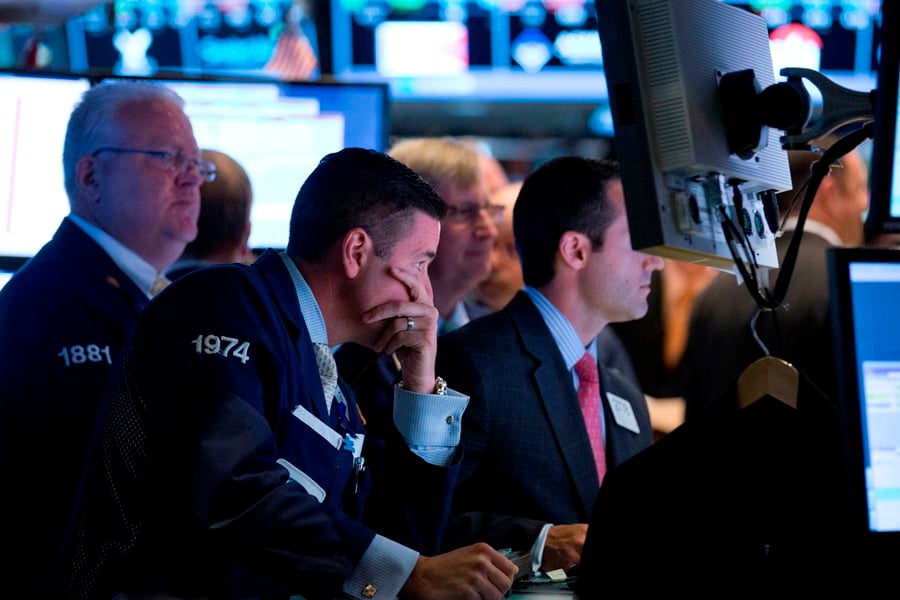September is the worst month for markets, historically, though compared with this August's turmoil, an average 1.1% drop in the S&P 500 seems tame.
In case the past month's volatility was just a warm-up, you might want to reflect on the power of some basics the tumult brought to light. You could think of them as investing mantras for volatile markets.
VOLATILITY IS NORMAL
A six-year bull run without that many big blips may have made a fairly steady ride feel like the new normal. As financial planner Harold Evensky reminded clients in August, "After an extended bull run, many investors forget that it is normal for stock markets to periodically see intra-year declines in the 5 to 10% range."
Intra-year drops of 5% from peak to trough, Mr. Evensky added, happen on average about four times a year, with a recovery period of two to three months. The drops can take place over days, weeks, or months, according to JPMorgan's Asset Management Guide to the Markets. Investors see 10% declines about once a year, on average, followed by a recovery period of about eight months.
http://www.investmentnews.com/wp-content/uploads/assets/graphics src="/wp-content/uploads2015/09/CI10120393.JPG"
Moral to that story: The recent market swings were pretty hellacious, but it was the lack of volatility for long stretches that was really abnormal.
YOU'RE DOLLAR-COST AVERAGING INTO THE DROPS
If you have a percentage of your salary deferred in a 401(k) or other automated investing program, you are buying into the market at regular intervals, regardless of its level. All that steady dollar-cost-averaging, year after year, means you're never buying a big stake at a market high (or, it's true, a market low). As Matt Levine of Bloomberg View put it in an Aug. 24 column, "Lower prices reduce the value of our current pile, but also cheapen the rest of the pile which we have to buy in the future."
A bonus: If you ever beat yourself up for not acting on the temptation to buy on the market dip, you probably did anyway, through your 401(k). You might not feel quite as
joyful about the market's plunge as columnist Felix Salmon, but you may have picked up some bargains.
LIMIT ORDERS CAN LIMIT THE PAIN
Most people who want to sell some stock don't need to do it immediately. That's good, because then they can use a limit order instead of a market order. A limit order affords protection if the market plunges. Say you own a stock trading at $30 and you put in a limit order to sell at $30. Your order will be filled only if a buyer pays you $30. If you put in a market order and the market dives, someone could buy your stock at, say, $25.
People selling exchange-traded funds into market swings found out how useful limit orders can be. In the midst of a big market drop (and a technology breakdown, unrelated to the market, that may have caused some investors to overpay for ETFs), ETF pricing got very weird. Mr. Levine on Aug. 26 (you might want to follow the guy): "Many stock ETFs fell much further than their underlying holdings did, because some of those underlying holdings were halted by stock exchange circuit-breakers."
INERTIA CAN BE YOUR FRIEND
It's a beautiful thing: If your 401(k) holds well-diversified, low-cost funds, you can largely ignore it and feel no guilt as it, yes, dollar-cost-averages away. Sure, if you're not in a target-date fund that rebalances automatically and your equity stake has grown a lot, you'd probably want to move some money out of stocks. But now the stock market has done it for you.
Not panicking in times of market turmoil tends to pay off. Fidelity Investments found that pre-retirees who sold all their equities in late 2008 or early 2009, near or at the market bottom, and never rebalanced back into equities saw their 401(k) balances increase nearly 26% as of 2013's first quarter, to an average of $101,000. That doesn't sound so bad, until you look at how the pre-retirees who didn't sell out of equities did. Their average balance nearly doubled, to $255,000.







